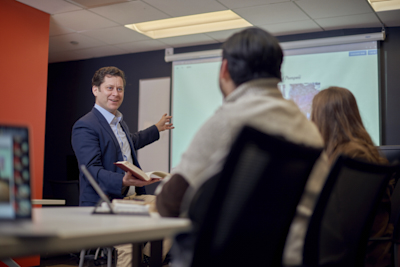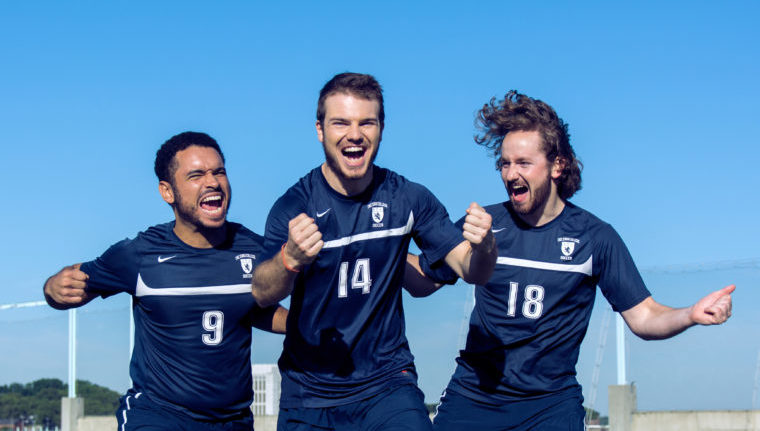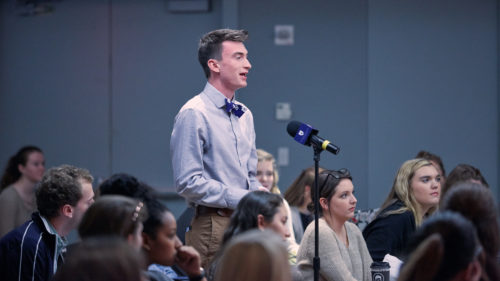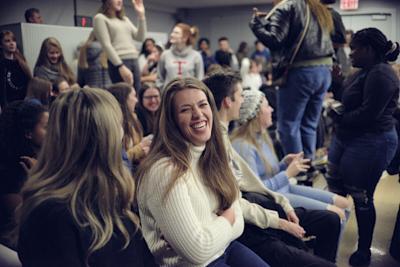What’s Old is New Again: The Creation of PPE
One might not initially hear such a phrase and think its main result would be a curriculum overhaul—but it appears that the story of The King’s College’s unusual core curriculum in Politics, Philosophy, and Economics (PPE) starts here.

“I want to buy this college.”
So said the late Bill Simon, former Secretary of the Treasury under Presidents Richard Nixon and Gerald Ford, to his friend Herb London in the 1990s[1]. One might not initially hear such a phrase and think its main result would be a curriculum overhaul—but it appears that the story of The King’s College’s unusual core curriculum in Politics, Philosophy, and Economics (PPE) starts here.
London went with Simon’s friend James Piereson, who is now the president of the William E. Simon Foundation, to visit King’s[2]. They toured the campus and talked to a number of staff and faculty members. “I asked Jim, ‘How much are you willing to invest? If you want to keep this facility in Westchester County, it will need a major overhaul. Plus, I looked at the curriculum, and the curriculum probably needs some overhaul. It has a distinct Christian orientation, but apart from that, the mission is not clear.’”
London recalls that Simon was willing to invest $5 million, but repairs to the building alone would have dwarfed that sum. “Eventually,” he says, “Mr. Simon stepped out.”
Was the College’s mission and curriculum unclear? That assessment may (or may not) feel brusque to alumni, but evidence from that time as well as the direction the College moved in subsequent years seem to indicate in the affirmative.
In the first place, both of the College’s first two presidents relied heavily on donations from their radio constituencies to finance the College’s operations[3][4]. This meant that for its first five decades or so, The King’s College never had significant, strategic, ongoing relationships with major donors, or the institutional resources by which such relationships are built and maintained. Since these sorts of donors are, generally speaking, a dominant force in pushing institutions to differentiate their missions, it is not surprising that London found the mission of King’s indistinct when he encountered it sixty years into its life.
Second, although the most dramatic mission overhaul would come to King’s with the presidency of Stan Oakes, the College was working to clarify and refocus its mission even before it closed. From an early 1990s recruiting brochure that spoke of the College’s proximity to New York City and the opportunities available there, to an anonymous donation designated for exploring the possibility of reopening in New York, to the model of relying on urban, ethnically diverse churches as a key recruiting pool that Friedhelm Radandt eventually pursued, change was in the wind.
Although Simon decided not to invest in King’s, London retained an interest in the College and took note when the newspapers announced that King’s had rented space in the Empire State Building. “At some point,” he recalls, “[the president[5]] called me and asked me about the transactions with Mr. Simon and talked to me about my recommendations for the curriculum.”
Although he did not have a close relationship with the College at that time, London was in a good position to be making curriculum recommendations. As an undergraduate, he attended Columbia University, where he was involved in a program on contemporary civilizations and humanities (CCHUM) and studied under the eminent historian Jacques Barzun. He says of this experience, “[Columbia was] the only Ivy League college that [had] this 2-year core curriculum, and I’ve always been impressed by it. For me, it was transformative. It introduced me to ideas in a manner I was not at all familiar with, and I always believed this is the basis of a very significant education.” He went on to earn his Ph.D. in history at NYU, where he started a program based on the one he had left at Columbia, which ultimately became the Gallatin School: “The premise of it was that I was far more interested in students being conversant in 87 great books than whether they had a major or a minor. . . That program received a fair amount of attention and traction.” He directed it until 1992[6].
So when King’s came asking for recommendations, London said, “Look, Oxford kind of has a Philosophy, Politics, and Economics program, and it’s. . . a tradition that has been embraced in part by the University of Chicago and in part by Columbia.” He thought it made good sense to institute a PPE program at King’s and was invited to write a paper on the topic, followed by an invitation to give several lectures about why PPE would be an appropriate direction for King’s: “I [talked] about the philosophical underpinnings of Judeo-Christian civilization. [S]tudents, in my judgment, should be reading the Greeks, should read and have some understanding of Shakespeare.” As he recalls, “I gave those lectures, and time passed, and I had no contact with The King’s College. I noticed the changes that happened at King’s, I wrote an occasional piece about friends of mine who were involved at King’s—but I had no involvement until I ran into Greg Thornbury[7].”
London may not have heard much for a number of years, but Stan Oakes was listening to those lectures. Oakes, who had run the Faculty Commons initiative with Campus Crusade for Christ before joining King’s, had been deeply influenced by several conversations with the Lebanese academic, diplomat, and philosopher Charles Malik, who among his myriad accomplishments wrote the United Nations Universal Declaration of Human Rights. Malik had once told Oakes that “Intellectuals think about the world politically, economically, and sociologically.” Oakes recalls, “He stopped. The moments lingered, and then I said, ‘You mean not spiritually?’ ‘Yes,’ he said. ‘Understand this and you’ll understand the ideas that move the world[8].’”
That conversation ignited what became a driving passion of Oakes’s life: to sort through the relationship between Christianity and academic disciplines that he saw as attempting to bring the world a technical, intellectual, political salvation apart from Christ, and to empower Christianity to speak and academics to listen to the greater truths that God has written into the world. When he took the presidency of King’s, he found in PPE a perfect platform to cultivate the marriage of faith and reason in students. As he puts it in a characteristically colorful phrase, “Putting Aristotle and Jesus together sounds a little abnormal, I guess. Certainly it does to committed believers who think the only truth in the world is inside the Bible as if God can’t find a way out of it. When I say it like that, they have another reason to worry about me. But remember that my goal here is to uplift the Bible in the real world and let God out of the religious ghetto of our minds and hearts[9].”
It appears that Oakes was working on the PPE idea even before he became president in 2003. Dr. Peter Wood, now President of the National Association of Scholars and former Provost of The King’s College from 2005 to 2007, was responsible for the curriculum design. He says, “I was corresponding with Stan Oakes about the possibility of a PPE program at TKC before the idea had crystallized. . . I was advising Stan before I was formally hired to advise the college. Stan and I first met in July 2002 and began corresponding then.” Of the design process, he recalls,
“We spent a lot of time figuring out what the essential courses were and in what sequence they should be taken. The main considerations were educational: what did students need to learn to have a PPE education rooted in biblical truth? How should foundational courses on the Bible, philosophy, economics, politics, and writing be articulated with one another? We considered what knowledge students were likely to bring with them from high school and in what ways we would have to counter the premises that students were likely to have absorbed from the surrounding secular culture without realizing it. We also needed a program map that would help students build on their knowledge from semester to semester. That may sounds obvious, but it is not the way much of American higher education works. Often students finds ways to take courses out of sequence, which undermines both teaching and learning. The teachers have to teach such courses in a way that makes allowances for what the students have skipped over, and the students get a compromised version of the subject. We wanted a program that was tightly organized to prevent those compromises.”
The creation of the PPE program was intellectually robust and coherent, and like other changes during that time at King’s, the rollout of the program commenced at once. When Oakes became president, he overhauled the mission without delay to focus on sending well-equipped Christians into key cultural institutions, and changes to the curriculum and student life followed quickly. Students who had been recruited from churches in Queens to play basketball arrived to find that there was no basketball program at King’s; high school valedictorians from the Midwest felt their faces drain of color when they were told at freshman orientation to expect C’s and D’s on their first papers. Nearly half the class that enrolled in the fall of 2006 left a semester later.
For faculty, however, and for students who stayed, the intense sense of mission that all this created was very effective. Wood recalls, “Faculty morale was very high. We called the faculty acting as a body ‘the collegium.’ We moved from a previous emphasis of treating faculty members as functional staff who carried out assignments determined by the administration to a body that fully participated in the shaping of the curriculum. Members of the faculty who had been there for several years and had seen a series of sudden changes in the curriculum were initially skeptical about PPE. And indeed, Stan had imposed PPE on the faculty by fiat before I got there, so initially I had to gain the trust of the faculty that we really would work together to turn the PPE core into a living reality. I would characterize the conversations as extensive, richly philosophical, prayerful, and earnest. We reached various decision points where one side or another had to be disappointed, but I think the conversations were powerful enough to overcome those disappointments.”
Dr. Robert Jackson, formerly a professor of education and literature as well as acting provost, and now Chief Curriculum Officer for Great Hearts Academies in Phoenix, Arizona, concurs: “I was particularly taken with the interdisciplinary approach to our common curriculum. . . [I]n the Age of the Multiversity and the Educational Smorgasbord[, it] provides a lexicon to unite students in their understanding of the world, while taking them more deeply into the sources of our civilization, given the philosophical and political origins of the West. I very much enjoyed the collaboration of my colleagues, in that same vein, for PPE provided us with a common framework for educating students and defining the terms of our engagement with the modern world[10].”
PPE at King’s has been a work in progress; alumni from Wood’s time and shortly thereafter habitually give a half-earnest scandalized reaction when they find out that current students are not required to take formative senior-level courses such as Civil Rights. Jackson remembers, “There were a handful of changes from 2007 to 2013 (when I left), mostly concerned with how to integrate Christian ethics, biblical hermeneutics, and literature (a personal concern of mine) within the PPE core. In addition, other programs were introduced to diversify the offering.” Concerns about connecting first-year students with classes in their major as early as possible have dictated other changes to the curriculum, especially to its sequence.
The core remains strong at 20 courses throughout a student’s career, but has also proved to be a productive root from which other majors have grown. Business Management coexisted with PPE from the beginning and partook of its core courses, and recently spun off a finance major; PPE itself has directly shaped the creation of more interdisciplinary majors including Media, Culture, and the Arts (MCA); Religious and Theological Studies (RTS); English; Philosophy; Humanities; and most recently Journalism, Culture and Society (JCS).
Though alumni of the early 2000s are apt to talk about this array of new majors along the lines of “proliferating like rabbits[11],” the uniqueness of the PPE core continues to attract students, parents, headmasters of classical schools, prospective donors, faculty, and even presidents. People have found that PPE sets King’s apart from the crowd of both Christian and secular schools and draws an intense interest. Indeed, the curriculum was a key factor in attracting Gregory A. Thornbury to join King’s as its current president, and he continues to expound on its merits: “PPE teaches students that problems are not obstacles or brick walls; they are opportunities for creativity. Intellectual creativity is a muscle, and exercising it is the particular specialty of the PPE core. Thus, a King’s graduate can think his way around all kinds of problems, especially after graduation, whether in the world of ideas or in the marketplace.”
It is no secret at the College or in its wider circles that the mission and curriculum changes at King’s were not always explained thoroughly or received warmly with alumni. It’s also a fact that no one who experienced the implementation of PPE speaks of it as if it was easy. What is also true, however, is that they do often speak of those times as special. When asked how he accounts for this, Dr. Wood offered a response whose wisdom may be compelling to audiences of all eras: “Those times were special: intensive, transformative, and in some ways redemptive. I account for them as God’s blessing on the college. None of us were so wise or capable as to make the experiment thrive the way it did. Much of the success was a matter of working as hard as we could towards a clear goal, and trusting that God would make the best use of our efforts. Personally, I embrace the idea that difficulties are to be expected and to be met in a spirit of gratitude[12]. The times were not easy—but that was a gift. Nothing good ever comes of things being easy.”
—
Special thanks to Rebecca Au ’15 and Jane Scharl ’12 for their help with this research.
[1] Interview with Dr. Herb London, March 13, 2017, conducted by staff writer Rebecca Au.
[2] Dr. London did not recall the exact year of this visit, but noted that faculty and students were on site at the time, indicating that the College had not yet closed. This would date his visit in or before 1995.
[3] Crawford, Dan. A Thirst for Souls. Susquehanna University Press, 2010.
[4] Interview with Bob Straton, July 2, 2016.
[5] Memories are not certain here, but most likely this was Friedhelm Radandt.
[6] Herbert London,” Wikipedia. Accessed March 27, 2017.
[7] London is now a Presidential Scholar at King’s, where operates The London Center for Policy Research on campus.
[8] Oakes, Stan. “Wake Up Call,” unpublished manuscript, ch. 1. Shared via email March 23, 2017.
[9] Oakes. “Intellectually Born Again,” unpublished manuscript, ch. 3.
[10] Email interview with Dr. Robert Jackson, conducted by staff writer Jane Scharl, March 26, 2017.
[11] Source shall remain nameless but lives in the writer’s household.
[12] This notion was adopted by Oakes as well. The writer distinctly recalls being a high school senior in late 2006 and, somewhat overwhelmed by a weekend of unexpectedly compelling language about the college’s mission, shrinking down between the arms of a chair as Oakes encouraged his audience of prospective students and their parents to “embrace the difficult life.”




